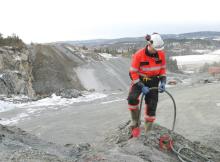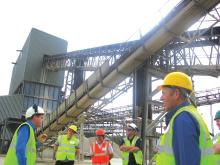
Ongoing operative training is an essential part of achieving the industry's targets on safety improvement
Regular toolbox talks can help keep the safety message as a high priority
Many quarries have worked hard in recent years to improve their safety records and it is pleasing to see that the number of sites that have now gone several years without incident is growing. However, it only takes one small mistake for this counter to be reset to zero, which is why ongoing operative training is essential no matter how good the record at any site.
However many safety features are added to quarry equipment and how good a company's safety policy is, unless it is put into practise on the ground day in, day out, the aim of reducing accidents will remain just an aim. But this rigorous application of risk assessment and safety precautions can make them appear routine and this complacency brings additional risks when operatives choose to take short cuts, even if they are for the best of reasons.
While regular off-site courses may be useful to bring managers and foremen up to date on the latest techniques and legislative requirements, this knowledge needs to be filtered down. Understanding of why a short cut presents a real risk to the operation is part of the battle in changing the mind-set of operatives and also helps to encourage them to look out for their colleagues.
Regular toolbox talks are a useful way of reminding the workforce about potential hazards and this kind of presentation does not have to be difficult to prepare. Online resources, such as www.safequarry.com, offer free downloadable talks on a wide range of topics from safe use of mobile equipment and daily vehicle safety checks through to risks from drugs and alcohol and manual handling.
Cemex France aggregates director Pierre Fèvre firmly believes that open discussion on safety was the key behind the recent achievement of 10 years accident-free at its Ventrouze and Bizou quarries. "This is the result of years of training, discussion and sensitivity to the question of safety, as well as team work where the behaviour of safety is naturally anchored," said Fèvre.
Strategies employed by the company included regular inspections and a 15 minute opportunity for workers to discuss accidents and potentially dangerous situations with management.
In the UK, Lafarge's Barnstone Works has also notched up a new safety milestone in May with 1000 days accident- free, despite the site undergoing major development during this period. Barnstone plant manager Chris Stephens said, "As well as having strict safety policies in place, we use risk assessment and safe working procedures to challenge the way we do things and this helps keep us all on the ball and avoid unnecessary risks. But we must continue with this resolute attention to safety so we can look ahead to our next target milestone." Nonetheless, it is not always possible to take account of every eventuality so reporting of near-miss incidents and potential hazards, as well as actual accidents, is very important. But the lessons learnt from these incidents needs to be passed on with clear guidance on how to prevent future issues from the same problem.
While some operatives may work in the quarry full-time and have a good appreciation of the specific risks to that site, many quarries are increasingly turning to contract workers for in-pit operations as well as maintenance. This unfamiliarity with the quarry brings additional risks for the whole workforce, so in-depth inductions should be carried out as a matter of course. However, clear signage on site and separation of the production and processing parts of the quarry from the loading area will help to reduce the risk.









